

The halfpenny may be thus described:
1. O. CAROLVS. A. CAROLO. The head of the king to the left, laureate. The bust in Roman armour.
This occurs of the dates 1672, 1673 and 1675.
Copper proofs of the halfpenny of 1672 occur, and a silver proof of the same date is known. Silver proofs of the
halfpenny of 1673 are in the National Collection and in my own, and a copper proof of the same year is in the cabinet
of Mr. Caldecott. The proofs of both years have a linear circle instead of dots towards the outer rim. The figure
of Britannia first occurs on this issue of copper coins, and is evidently an imitation of a similar figure in almost
the same position on some Roman pieces; notably on those of Hadrian and Antoninus Pius, and the well-known medallion
of Commodus. The portrait has been supposed to be that of the beautiful Frances Stewart, afterwards Duchess of Richmond
whose features were certainly depicted upon the face of Britannia on the Breda Medal of 1667 (Med: Ill: I., 535-186),
as stated by Pepys in his Diary under date February 25th, 1667.
2. The farthing is of the same type as the halfpenny, except that the right leg of Britannia is bare. R. 2.
It occurs of the dates 1672, 1673, 1674, 1675 and 1679. In addition to these dates, farthings of 1671, some with the
King's bust with short hair, others with long hair occur, but are excessively rare in copper, and more so in silver.
I have only met with examples in the last mentioned metal, with the King's bust with short hair. The farthings of
1671 were probably designs by Roettier struck in anticipation of the proclamation. Mr. Batty states that a farthing
of 1676 is in the collection of Mr. Henry Brown of Liverpool.
There is a farthing in the National Collection, apparently of 1670, but it has clearly been altered from 1679. In
the collection of Mr. R. A. Hoblyn is an ordinary farthing of 1673, on the obverse of which the legend runs
CAROLVS. A. CAROLA.
3. In the year 1684, the plan for striking tin coins, which had been mooted so far back as 1679, was carried into
execution. It was ordered that a halfpenny and farthing should be prepared, but the farthing alone was sturck. It is
in type, size and weight, precisely the same as the copper farthing. It has a square stud of copper in the centre,
and bears round the edge, the legend NVMMORVM. FAMVLVS. 1684., the date being removed from the exergue
of the reverse.
This legend is variously arranged. I have noted three varieties.
(I.) With a mullet both before the date and after NVMMORVM.
In the cabinet of Mr. R. A. Hoblyn, is one dated 1685, which is probably one of the many forgeries of the period,
seeing that the King died on the 6th of January, 1685 - this, according to the Old Style then in force, being in the
year 1684.
PATTERNS OF CHARLES II.
The only pattern for a halfpenny, except that of the QVATVOR. MARIA. VINDICO. type afterwards
mentioned, is as follows:-
1. O. CAR. II. D. G. M. B. FR. ET. HI. REX. m. m. a rose. A three-masted ship, sailing to the left.
This occurs in pure copper, and in the same metal with a broad band of brass; also wholly in brass, and sometimes,
but rarely, in brass with a broad band of copper. Proofs in silver are also known.
There are some pieces which have been described as being probably patterns for halfpennies of this reign, having
the head of the king on one side and that of the queen on the other, but which are clearly medalets or jettons,
as also are the following three pieces, although they are included among the coins of the realm in the National
Collection.
(a). O. CAROLO SECVNDO. Bare head of the king, under it P. R. (for Phillip Roettier).
The last is struck in silver and tin as well as in copper, and would almost appear to be of foreign workmanship. It
is perhaps attributable to the monarch of some country other than England.
The first pattern for a farthing is one very similar in design to, but much larger and heavier than, the Harrington
token, or harp farthing, of Charles I. and his predecessor, and was intended to be issued for currency in Ireland only
under St Thomas Armstrong's Patent, dated at Westminster, December 14th, 1660. There are examples in copper in the
cabinets of Mr. R. A. Hoblyn and of myself, and I have a probably unique specimen in silver. The general appearance
and workmanship, as well as the great rarity of the pieces now extant, afford sufficient evidence that they are
patterns only, and it is a matter of history that the current farthing was never issued for circulation, owing
chiefly to the exertions of James, Duke of Ormond, Lord Lieutenant in 1662. Its description is as follows:-
2. O. CAROLVS. II. D. G. M. B. A large double-arched crown, behind which are two sceptres in saltire.
To 1660 may be assigned five patterns for farthings, two of which bear that date, the others being evidently issued
at the same time. If these were not (as they most probably were) the work of Thomas Rawlins, they might be
attributed to David Ramage who did not die until 1662, on the 5th of November in which year, a warrant was issued
by Charles II. ordering the removal from the Mint buildings of his widow and children (Mint Record Book, No. IV.).
3. O. SVCH. GOD. LOVES. m. m. a rose. Small diamonds between the words of the legend. The head of
Charles I. Small R. beneath.
4. O. Same as No. 3, but no R. beneath.
The reverse of this coin is evidently suggested by the 1640 pattern farthing of Charles I. by Briot (No. 14).
5. O. CAROLVS. II. REX. m. m. a rose. After CAROLVS. and II. a mullet;
after REX. a diamond. The bust of Charles II. to the left within an inner circle. R. 6.
6. O. Three interlinked pillars surmounted by a crown and bearing St. George's Cross, the Irish harp and the
Scotch thistle respectively, between C. R. crowned. No legend.
7. O. Same as the reverse of No. 4.
This occurs in copper and silver, and an example in tin (but with the date 1661 instead of 1660) was lately in the
cabinet of Mr. A. E. Copp, and a piece in silver with the same date and with a grained edge is in the National
Collection; and a similar piece in the same metal and with the same date, lately in the cabinet of Mr. W. Brice,
is now in my own. This is of double thickness, and the edge is obliquely grained in a somewhat careless fashion.
The following patterns of farthings are of uncertain position, but resemble in some respects the tokens of previous
times, and I think, therefore, they should be placed early in the reign:
8. O. THE. KING'S. GRACE. IS. A crown within an inner circle. m. m. a mullet.
9. O. Similar to No. 8, but m. m. rose; a small mullet after KING'S.
This piece is in bell-metal, and is in my own collection. An example in tin is also in the National Collection.
The next type of pattern for a farthing is dated, and its position, therefore, is more easily ascertainable:
10. O. CAROLVS. II. DEI. GRATIA. The king's bust draped and laureate, from the die, apparently, of the shilling
of 1663.
This piece is of pure copper. I have one in my collection which reads MAG. BR. FRA. ET. HI. REX. 1663.,
on which the date is wholly between two of the crowns instead of being divided. I have another which reads
MAG. BR. FRA. ET. HIB. REX. 1663., on which the date is divided by one of the crowns. I have also
one of the latter in pure silver, which is probably unique.
The next patterns which I propose to describe are those of the QVATVOR. MARIA. VINDICO. type. They
consist of a halfpenny, of several farthings, and of two pieces intermediate in size between the two. The legend, which
means "I claim the four seas," is said to have given offence to Louis XIV. of France, in deference to whose views
these patterns were not further proceeded with. It is possible that these coins would have been immediately
struck for circulation had it not been for the objections of the French monarch; for when in 1672 a copper currency
was issued for general use, the same type was retained with the omission of the offensive legend. The halfpenny may
be thus described:
11. O. CAROLVS. A. CAROLO. The king's bust in Roman armour to the left, laureate. The hair short. Linear
inner circle. No date.
Proofs exist in silver and copper.
The following two pieces are in silver only. They are larger than the usual farthings but were clearly intended
to represent that denomination, as the right leg of Britannia on the reverse is bare, a characteristic peculiar to
the farthings only.
These farthings were at one time called Lord Lucas's farthings on account of his speech in the House of Lords,
February 22nd, 1670-1, when he complained of the scarcity of money. "And it is evident that there is scarcity of
money, for all the parliament money called 'breeches' (a fit stamp for the coin of the Rump) has wholly vanished;
the King's proclamation and the Dutch have swept it all away, and of his now Majesty's coin there appears but very
little, so that in effect we have none left for common use but a little lean coined money of the late three
former princes. And what supply is preparing for it, my Lords? I hear of none unless it be of copper farthings, and
this is the metal that is to vindicate, according to the inscription on it, the dominion of the four seas" (Speech
printed at Middleburg, 4to. 1673, and subsequently burned by the common hangman.)
Although of a much later date, they are described here for the sake of convenience, having regard to the
similarity of their type to that of the foregoing and subsequent pieces:
12. O. Similar to the last, but the hair long and flowing. Under the head, the date 1675. Edge plain.
13. O. and R. Same as before, but with the date 1676. R. 2.
The QVATVOR. MARIA. VINDICO. farthings may be divided into two types; the one referable to the
year 1662, and the other to the years 1665 and 1666. The first type presents the following varieties:-
14. O. CAROLVS. A. CAROLO. m. m. a lion. A rose, thistle, harp and fleur-de-lys, each crowned and
placed crosswise.
15. O. Same as No. 14.
16. O. Same as No. 14.
16A. The same coin with the edge plain. In my own cabinet.
16B. The same coin on a thinner flan with graining to the edge of piece. In Mr. Hoblyn's cabinet and my own.
17. O. Same as No. 14.
The above four varieties are only found in copper, except No. 17, which occurs in silver with a plain edge in the
National Collection. The second type gives us the Figure of Britannia on the reverse, and on the obverse the King's bust
well executed.
18. O. CAROLVS. A. CAROLO. The king's bust in Roman armour and laureate; beneath, the date 1665;
the hair is short. A broad rim.
19. O. and R. as before, but with the king's hair long and flowing. R. 5.
Both the last-mentioned pieces have sometimes the rim narrow, and the coin is then smaller in consequence. They also
exist with the date 1666. They are found in both copper (or copper bronzed) and silver, of which the former is by far the
rarer metal. Two very rare varieties of No. 19 exist in tin; one larger, with a circle of bell-metal introduced, and one
smaller, with a circle of copper. Both are in the National Collection. In my collection is a specimen of No. 19 in copper,
with a circle of brass and with a grained edge; another example occurred in the collection of Mr. W. Brice. I have also
(from the Brice cabinet) an example of the same pattern in brass with a ring of copper.
The edges of these coins, Nos. 18 and 19 vary. They are sometimes plain, sometimes lightly grained, and at other times
very coarsely grained; but I have not hitherto met with a copper specimen of No. 19 with the last-mentioned edge, though
I have seen it in silver. In my own collection is an example of No. 18 with a plain edge, struck in gold, and one struck
in the same metal appears to have been sold in the Thomas Collection (Lot 918) many years ago, and was probably the
same specimen as that in the Chetwynd Collection (Lot 98), and subsequently in the Bale Collection, and is now in that
of Mr. Richardson, of Edinburgh. In the Thomas Collection (Lot 917) was also included a gold pattern of No. 19. In the
National Collection are gold specimens of both varieties, and both have grained edges.
I have a copper specimen of each of the above-described patterns (Nos. 18 and 19), from the Brice cabinet, both
of which have the edge coarsely grained, but which differ in being of a substantially larger module than the ordinary
patterns. A similar specimen of No. 18 is in the collection of Mr. R. A. Hoblyn. They are exceedingly rare. I have
also (from the Brice cabinet) a copper example of No. 18, of the ordinary size, on the edge of which is inscribed
ISTA. FAMA. PER. AETHERA. VOLAT. This is probably unique.
The following patterns for farthings are described in an order which they may not, all, chronologically deserve;
but it may be fairly assumed that those in tin were issued later, rather than earlier in the reign, as the tendency
to coin in that metal was certainly of later growth, and was followed by the succeeding monarchs, on account of the large
percentage of profit obtained by them in connection with such coinage. In addition to this, the records of the Mint
show that various negotiations took place between the government and the miners of Cornwall, about the years 1679 and 1680
with reference to a coinage of tin. These negotiations all failed, because each side wanted to monopolize the profit, and
the manufacturers refused to take back pieces not of their own manufacture. Some of the pieces which will be referred
to may be doubted to be coins or patterns for coins at all, but I have given them the benefit of the doubt, and
have excluded others which, in my opinion are distinctly medalets or jettons, though described as patterns for coins
by other authors.
20. O. Two C's interlinked, crowned.
This is described and figured (Vol I., 477-85) in the Medallic Illustrations of the History of Great Britain
and Ireland, printed in 1885 by order of the Trustees of the British Museum, and is referred to as a small
medalet struck probably for sale in the streets at the time of the King's Coronation. There is a variety
of this piece in the National Collection, having the two interlinked C's in the written character, and very
slender, and the border of the coin is beaded, instead of being of a flowery nature as on the ordinary type.
Another variety in the same collection is of finer workmanship, and the rose is somewhat larger and of bolder
work, and the inner linear circle is wanting.
21. O. Same as No. 20.
22. O. Same as No. 20.
These last three pieces are struck on very small thin flans of bad brass, and are generally found silvered, and there
is no legend on either the obverse or the reverse of any of them.
The patterns which are now about to be described, are with the few exceptions which will be mentioned, found
only in tin or pewter, and mostly with a circlet of brass or bell metal introduced. This introduction was for the
purposes of rendering the task of counterfeiting them more difficult.
23. O. CAROLVS. II. D. G. MAG. BR. FR. &. HIB. REX. m. m. small lis. Two C's and two R's in monogram,
crowned.
I have not seen any example of this piece elsewhere than in my own collection, but a variety of this pattern in the
National Collection has the m. m. cinquefoil, the punctuation is different, and a circle of brass is introduced
in the centre of the coin.
24. O. As No. 23, but sometimes MAG. BRI.
25. O. As No. 23, but with the legend CAROLVS. SECVNDVS. DEL. GRATIA. m. m. small mullet. Edge grained.
This piece is also found in pure copper with a plain edge, and a probably unique specimen in fine silver with plain
edge is in my collection (from the Brice Cabinet).
26. O. CAROLVS. II. DEI. GRATIA. m. m. a cinquefoil preceded by a large ornamental scroll. Two C's
interlinked, crowned.
In this piece a ring of bell-metal sometimes encloses the cypher.
27. Another variety of the same pattern has a lion at the commencement of the legend on the obverse, and an ornamental
scroll at the end of the legend on the reverse.
28. Another variety of a smaller size in the National Collection, in that of Mr. Hoblyn (ex Copp Coll.) and in my own,
has a circle of copper, and the m. m. on the obverse is a mullet, and on the reverse, a small cross. This coin is
somewhat smaller and thicker, the interlinked C's are larger and there are other minor differences of design.
29. O. CAROLVS. A. CAROLO. The words divided by roses. A rose crowned.
This piece is grained on the edge, and is thicker than any of the other patterns. The following variety is not
only interesting in itself, but goes near to fix the date at which it was struck.
30. O. and R. As No. 29, but with the inscription on the edge CHARITAS. REGIA. LOND. RESTIT. R. 7.
This piece occurs in my own collection (from the Brice cabinet), and in the National Collection. The conduct of the
King at the time of the great fire, and the zeal which he displayed in connection with the restoration of London
afterwards, stand out in favourable relief from the general tenor of his voluptuous life, and he might not be
unwilling to leave some numismatic record of it. As the fire took place in 1666, this pattern was no doubt struck in
or about 1668.
31. O. as No. 29, but the words are divided by pellets and not roses.
This is in my collection (from the Brice cabinet). I have not seen it elsewhere. It is struck on a small but
very thick flan of tin, with a grained edge.
32. O. CAROLVS. II. D. G. The four symbols-the rose, lis, thistle, and harp, crowned and arranged crosswise.
This is mentioned by Christmas, but I have not succeeded in seeing any example of it; but a tin pattern, specimens of
which are in the National Collection and in my own, reads
33. MAG. BR. FRA. ET. HI. REX. 1676, on one side, and the same, but HIB. instead of
HI., on the other side. Edge plain. R. 7.
This is evidently composed of two reverses. It is of importance in determining the dates of these patterns. The
device on both sides consists of the four symbols crowned, the centre of the cross being filled by four C's interlinked,
but owing to the different positions of the date, the disposition of the symbols on the one side is in the shape
of the cross of St. George, and on the other in the shape of the cross of St. Andrew. Mr. Barré Roberts, in
his manuscript catalogue (in my possession) of his coins which were privately purchased for the National Collection,
writes: "This piece and five more were in the collection of Mr. Halsey and are the only ones known. The six
pieces were wrapped up in separate papers, and in each paper was written, evidently a long time ago, Tynne 6 oz., Lead
4."
I have a probably unique example struck in silver on a thick flan, weighing 131 grains.
34. O. CAROLVS. II. DEI. GRA. A harp surrounded by the garter, bearing its motto HONI. SOIT.
QVI. MAL. Y. PENSE. The whole crowned.
This piece occurs with a ring of copper or bell-metal. One in my collection on which is introduced a small ring of
copper, has the inscription on the edge NVMMORVM FAMVLVS 1684, being of importance also in fixing the
date of this and similar patterns, which were no doubt issued in connection with the tin currency coinage inaugurated
in that year. I have another example (from the Brice cabinet) on which the ring of copper does not appear.
35. O. and R. Same as No. 34, with the exception of the legend, which on one side reads PER. MARE. ET. TERRAS.,
and on the other, PER. MARE. ET. TRRAS. (sic). The edge is plain. R. 8.
This pattern piece in my collection does not appear to have been before described. The specimen in the National
Collection has the edge inscribed, SVBSIDIVM CAMBIENDI, after which appear traces of a date 167- (the last
figure illegible); this would show that this pattern must precede, at all events, the lastly described one.
36. O. CAROLVS. II. D. G. MAG. BR. FR. ET. HI. REX. A crown. m. m. a pierced cinquefoil.
This piece is of mixed metal, whiter than brass, and more yellow than tin. It also occurs in copper. The legend may
be explained by reference to the type of No. 23.
37. O. CAROLVS. A. CAROLO. The four emblems, the rose, thistle, harp and lis-each crowned, and arranged
crosswise.
This is struck on a tick piece of tin with grained edge. A specimen is in the National Collection.
38. O. As No. 25.
This is of copper, and of very rare occurrence. It is a remarkable piece, as the same reverse appears subsequently on
patterns (or jettons?) of Mary II., and it probably belongs to the same category of pieces. In the sale of John
Henderson's coins (Lot 241) was a piece with the same obverse, in fine pewter. The reverse was inscribed
"1665 COVENT GARDEN. MDT."; evidently a ticket of admission and valuable as giving a date. There
were also some 17th century tokens with similar obverses, doubtless from the hand of the same engraver.
The Copper, Tin, and Broze Coinage of England
H Montagu, F.S.A, , 1893
Charles II
Charles II, 1660-1684
Until the year 1672 no copper coins were issued for currency in this reign, but patterns in great variety, both
as regards metal and workmanship, appear to have been struck, and will be treated of hereafter. On the 16th of
August, 1672, the king's proclamation was issued making the new halfpenny and farthing a legal tender only
for sums less than sixpence, and penalties were again proclaimed against private tokens, which had previously
been put into circulation to a very considerable extent to meet the requirements of trade, but the coinage of
which was soon after the proclamation mentioned, wholly discontinued.
R. BRITANNIA. The figure of Britannia seated, leaning on a shield which bears the
combined crosses of St. George and St. Andrew; in her right hand she holds a palm-branch and in her left a spear.
Neither leg is bare. In the exergue is the date. R. 2.
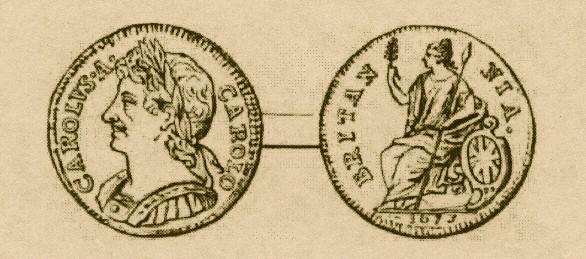
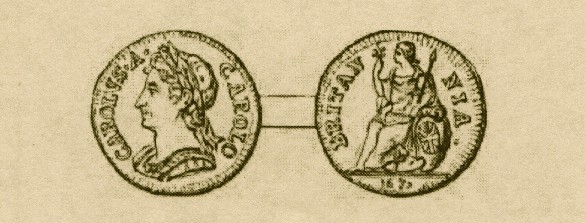
(II.) With mullet before NVMMORVM, but not before date; and
(III.) With no mullet before either.
R. SOLI. DEO. GLORIA. St. Michael piercing the dragon. R. 4. A star appears
at the bottom of both the obverse and reverse though only depicted on the latter in the engraving.
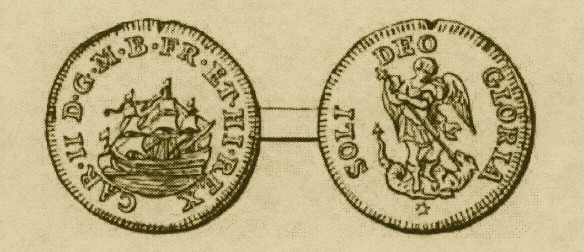
R. QVIESCIT. A sleeping lion. In exergue, BRITAN.
(b). O. As before.
R. ANTE. OMNES. A rose tree with a full-blown rose.
(c). O. C. R. in ornate written characters, direct and retrograde, forming a very complicated pattern,
difficult to decipher.
R. A large crown. The sun to the right rising over a landscape. No legend.
R. FRA. ET. HIB. REX. A female-headed harp, surmounted by a small double-arched crown.
m. m. a plume.
R. THVS. VNITED. INVINCIBLE. The three interlinked pillars. Same diamonds and mint
mark. Copper R. 7. (Snelling, Copp. Coins, Pl. 6, No. 11, on which, however, the R. under the
bust does not appear.)
R. TRVTH. AND. PEACE. m. m. a rose. A mullet between the words and a diamond at the
end of the legend. A rose crowned between C. R. crowned; under the rose, the date 1660.
The whole within an inner circle. Copper. R. 5.. (Snelling, Copp. Coins, Pl. 6, No. 12.)
R. Same as No. 3. This occurs in silver only.
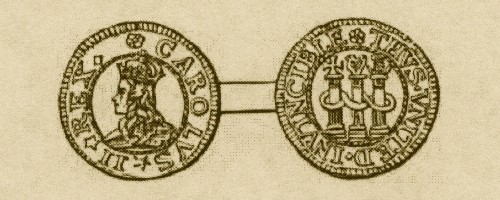
R. Same as obverse. Copper. R. 8. (Snelling, Copp. Coins, Pl. 6, No. 14.)
R. Same as the reverse of No. 3, but sometimes with a small R. under the pillars.
R. 6. I have one example in copper with the small R. bearing the m. m. mullet, instead of the
usual rose. R. 8.
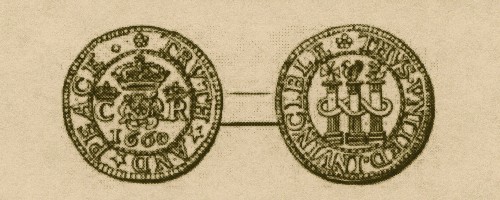
R. THE. POORES. RELEIFE. The king's bust crowned, in the branches of a tree.
m. m. a rose. Round the edge, the legend CAR. II. D. G. M. BR. F. ET. H. R. R. 7. (Snelling,
Copp Coins, Pl. 6, No. 21.)
R. Same legend as on No. 8, but three crowns as well as the king's bust in the branches of the tree,
which is doubtless the famous royal oak. The inscription on the edge is CAROLVS. II. D. G. ANG. FRA. ET. HIB. REX.
followed by a small rose. R. 8.
R. MAG. BRIT. FRA. ET. HIB. REX. 1663. The four symbols crowned and disposed
cross-wise. In the centre four C's interlinked. R. 6.
R. QVATVOR. MARIA. VINDICO. A figure of Britannia wholly draped seated on
a globe, holding in the right hand an olive branch; in the left, a spear. In the exergue, BRITANNIA.
R. 4.
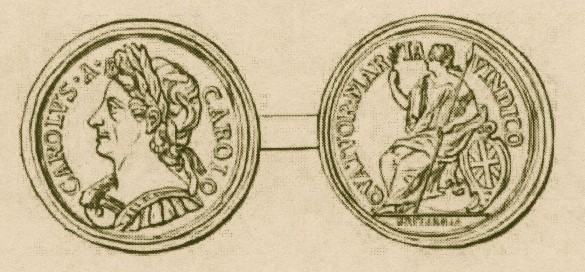
R. Similar to that of No. 11, but the right leg is bare, and the word MARIA is
differently divided, the letters MA being to the right of the olive branch, and RIA to
the right of the spear.
R. QVATVOR. MARIA. VINDICO. A ship sailing to the left; around the edge,
the legend MONETAE. INSTAVRATOR. 1662. A mullet before the date and a cross pattée after it,
sometimes also an ordinary cross before the cross pattée. R. 6. (Snelling, Copp. Coins, Pl. 6, No. 18.)
R. Same as No. 14. Legend on the edge, ISTA. FAMA PER. AETHERA. VOLAT.,
followed by two mullets and a cross. R. 6.
R. Same as No. 14. Edge grained, but the graining does not reach the centre of the coin. R. 4.
R. CAR. II. D. G. M. B. FR. ET. HI. REX. A ship sailing to the left. Legend on
the edge * * ISTA. FAMA. PER. AETHERA. VOLAT. +. (Snelling, Copp. Coins, Pl. 6, No. 19.)
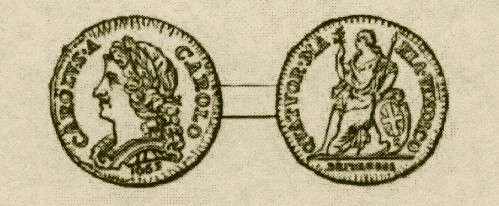
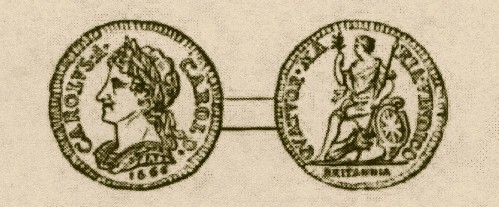
R. QVATVOR. MARIA. VINDICO. The figure of Britannia as on No. 11, but in this,
as in the case of all the farthings of this type, the right leg is bare. In the exergue BRITANNIA. R. 4.
R. A rose occupying all the field. (Snelling, Copp. Coins, Pl. 6, No. 28.) R. 2.
R. Three sceptres crossed; on the top of each a crown. R. 6. (Snelling, Copp. Coins,
Pl. 6, No. 26.)
R. A crown. R. 6. (Snelling, Copp. Coins, Pl. 6, No. 27.)
R. THE. POORES RELEIFE: A figure of Charity holding one child in her arms,
and another by the hand. The same m. m. A very inaccurate representation of this is given in Snelling, Copp. Coins,
Pl. 6, No. 22. R. 8.
R. Four sceptres crossed. m. m. mullet. ENGLAND., SCOTLAND., FRANCE, IRELAN.
This has a circle of copper introduced. R. 5.
R. MAG. BRIT. FRA. ET. HIB. REX. m. m. rose. The four scepters crossed in
saltire. This also has a circle of copper. R. 6.
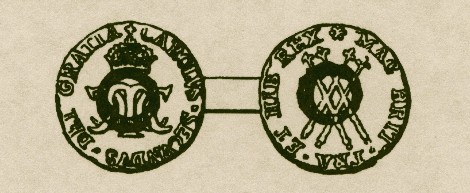
R. MAG. BRI. FRA. ET. HI. REX. The four scepters crossed in saltire.
m. m. a cinquefoil preceded by two smaller scrolls. R. 5.
R. NVMORVM. FAMVLVS. A three-masted ship in full sail, to the left. R. 6.
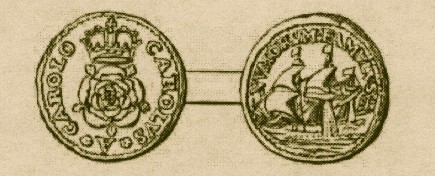
R. A three-masted ship as on No. 29, but the legend is CAMBIENDI. SVBS. (for
SVBSIDIVM.). R. 8.
R. MAG. BRIT. FRA. ET. HIB. REX. Same as obverse. R. 8.
R. MAG. BRI. FR. ET. HIB. REX. A rose surrounded by the garter
bearing its motto; the whole crowned. R. 8. (Snelling, Copp. Coins, Pl. 6, No. 17, on which FR.
is mis-spelt TR.)
R. TERRAS. CHARITAS. REVISIT. Four C's interlinked in the form of a cross
as on the Maundy groats. m. m. a cinquefoil. R. 7. (Snelling, Copp. Coins, Pl. 6, No. 20)
R. CAMBIENDI. SVBSIDIVM. A tree; on each side of the trunk, two C's interlinked.
R. 8.
R. EX. NOCTE. DIEM. The moon shining among clouds over a landscape. Edge plain.
R. 8.